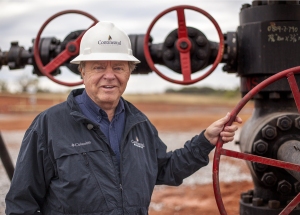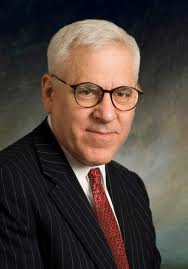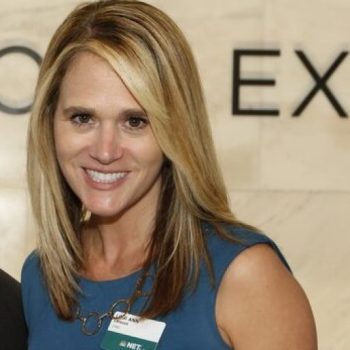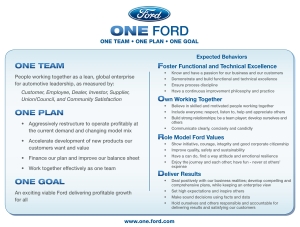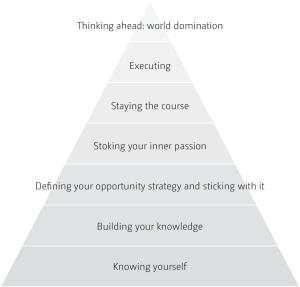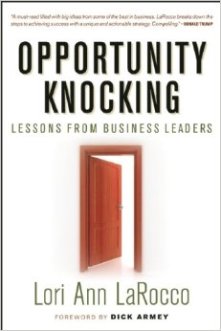 Over the course of my 22 years in journalism I have come to know many titans in a variety of industries and what I have found out is it doesn’t matter if you are Alan Mulally of Ford Motor Company (F), Ron Kruszewski of Stifel Financial (SF), public equity titans, David Rubenstein of The Carlyle Group (CG) and Ralph Schlosstein of Evercore Partners (EVR) or even Harold Hamm of Continental Resources (CLR)- they all share one distinctive trait– a strong corporate culture. By creating a culture that embraces the goals of your mission statement a company can be successful. Culture is the rebar that holds a company together. Creating that culture starts with the leader of the company; he or she is responsible for jumpstarting the organization’s culture.
Over the course of my 22 years in journalism I have come to know many titans in a variety of industries and what I have found out is it doesn’t matter if you are Alan Mulally of Ford Motor Company (F), Ron Kruszewski of Stifel Financial (SF), public equity titans, David Rubenstein of The Carlyle Group (CG) and Ralph Schlosstein of Evercore Partners (EVR) or even Harold Hamm of Continental Resources (CLR)- they all share one distinctive trait– a strong corporate culture. By creating a culture that embraces the goals of your mission statement a company can be successful. Culture is the rebar that holds a company together. Creating that culture starts with the leader of the company; he or she is responsible for jumpstarting the organization’s culture.
A company’s culture is the essence of how managers and employees approach
and execute plans, and this culture comes from the top. Management needs to put in place a clear set of objectives, and everyone in the organization has to believe in them to execute plans effectively. For Carlyle’s Rubenstein, his formula for creating a culture that fosters innovation and performance is the same in every Carlyle office around the globe.
“We have a ‘One Carlyle’ culture, which means everyone is truly a member of one firm and they are incented to make sure they work as one firm, or they will be penalized if they don’t,” he explains. This framework provides the comfort of inclusion and the guidelines employees need to thrive.
No matter which Carlyle office you are in around the world, the company’s long-term philosophy is present in tangible items to remind employees that they are all in this together, from visual reminders on employees’ desks to posters in the lunchrooms. Culture is a living, breathing creature. You have to nurture it and foster it over time. Rubenstein emphasizes the culture by awarding one employee in the world each year with a One Carlyle award which is considered to be the highest honor an employee can receive.
For fellow private equity titan Ralph Schlosstein, its culture of inclusion of employees and the ownership their employees feel because of their contribution is key to Evercore’s success. When asked about one of the greatest life lessons he has learned he said it was very simple, “Focus relentlessly on culture.” Schlosstein said that winning combination of inclusion and ownership has fortified an environment of growth for Evercore. In order to do this, Schlosstein explains, you need to have a clear strategy that is responsive to both your environment and the relative strengths of your business. “If you do one without the other, you lose. If you create a business plan that is not relevant to the world as it is today, failure is probable,” he says.
This culture based on the value of human capital is also present in the auto industry. Ford may be a global company, but the model Mulally uses to structure his company is something any entrepreneur or business leader can apply. He calls it the “One Ford” plan (see attachment)
This tiered, focused One Ford plan illustrates the culture of Ford. Mulally and his team meet every week, enabling Mulally and his team get to know each other extremely well: “You know you can’t fool anybody. Without leadership sharing the same vision and communicating about how they would execute, the One Ford plan would cease to exist.” Mulally said. As with any plan, it must be executed properly to be effective, CEOs need to set the example and Mulally says it sets the tone for the employees. Known for his unbelievable memory and able to recall someone after meeting them just once. A Ford employee told me about being “blown away” by his memory when walking with him on the floor of the Detroit Auto Show. Mulally went out of his way to go say hello to a dealer he’d met the year before, remembering his name and the dealership he ran. “It’s things like that that motivate you,” the employee told me. “He truly cares about the employees. Everyone is important to the overall plan.”
Mulally’s story also shows that good leaders should have the courage to not only see what business opportunities lie ahead, but also to value human capital and recognize the opportunity a healthy culture creates.
“Consistency is key when trying to achieve a goal,” Mulally stressed. He said if his employees did not share this vision, they left. It’s not that they weren’t performing; they just didn’t have the commitment or passion the company was looking for.
Part of nurturing a culture is by having CEOs who are willing to not only listen to their employees but to also constantly raising the bar of excellence for themselves.
“I have never told my employees that I know everything,” said Ron Kruszewski, “I don’t, and I’m open to change. Our organization today is the melding of many deals. We are one firm today, but we are the best because of all the different firms that make up Stifel. Your infrastructure has to be prepared. That’s the bottom line.”
Kruszewski did not hesitate when describing his endgame: “I always say I want to be able to double the firm tomorrow if I have to. And that’s how I approach my business. I have the people and the plan to be able to increase the firm very quickly in terms of our capability; I just don’t know when it’s going to take place. If you set the right culture and
thought process, growing a company with people who are nimble and thrive on change is self-selecting.”
Not only does this foster a positive environment, it can also help improve productivity. As Kruszewski puts it, “You have to invest a lot of authority with your key people. You motivate them, and they like it. This positive reinforcement builds the culture.”
Leaders like Mulally and Kruszewski do not view the loss of such employees as negative, because those employees didn’t enhance the organization in the first place. It
doesn’t matter if you are the employer or the employee—having a successful
culture begins and ends with value. Every person in an organizattion should bring value and passion to the table.
Out in the oil patch, Harold Hamm said the culture of Continental Resources is always being nurtured through his own personal improvement. “I have gone through tremendous growth myself as an individual. Obviously, you go through different stages, and you have to continually readdress what you are doing as a leader and get ready for the next stage and set of challenges facing you going forward. I’ve learned to do that. That’s the part of the job that keeps it interesting. Not a lot of people do it, and they stop along the way because their lid can’t be lifted anymore. I’ve always liked change and I thrive on changing and growing the company…. This passion is something I built into the culture of my company. Everyone in my company likes change and likes growth. We are a growth company. It is a challenge, but it’s who we are. It’s been a heck of a ride. Some employees have been with me for more than 30 years.”
Creating a positive culture is key to all these leaders’ foundations—as Schlosstein described it, “You need to be a long term believer in the things that enhance productivity.”
Even the tchotchkes and posters in Carlyle’s offices have helped foster their One Carlyle message. Productivity is nurtured in a variety of ways.
Lee Iacocca sums this up perfectly, “In the end, all business operations can be reduced to three words: people, product, and profits. Unless you’ve got a good team, you can’t do much with the other two.”
